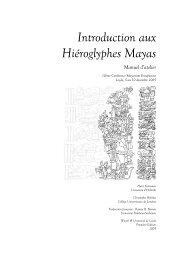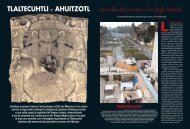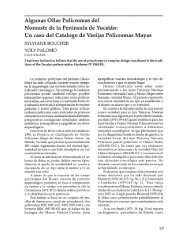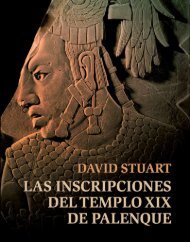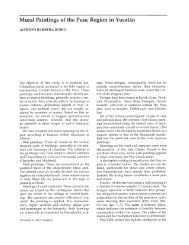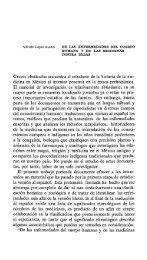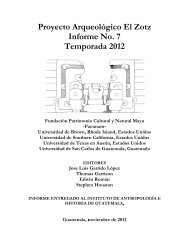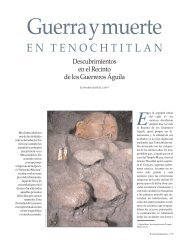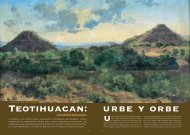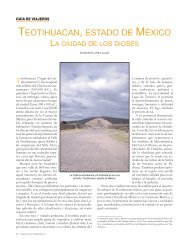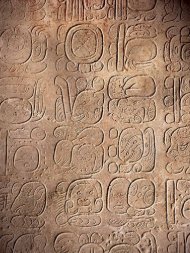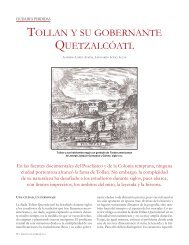A Late Preclassic Distance Number - Mesoweb
A Late Preclassic Distance Number - Mesoweb
A Late Preclassic Distance Number - Mesoweb
You also want an ePaper? Increase the reach of your titles
YUMPU automatically turns print PDFs into web optimized ePapers that Google loves.
A <strong>Late</strong> <strong>Preclassic</strong> <strong>Distance</strong> <strong>Number</strong><br />
coefficient for days on the San Bartolo block would be the<br />
potential “zero” superfix just discussed, as it appears to<br />
extend into the left corner, covering both the main sign<br />
and the prefix or the whole horizontal space of the glyph<br />
block. The two dots in the prefix, a graphically reasonable<br />
“two,” would correspond to the uinal portion of the<br />
DN, since it covers its vertical space. In other words, the<br />
morphological segmentation of pA4 and the analysis of<br />
its affixes suggests that it begins a new sentence, with<br />
the narrative projected either backwards or forwards in<br />
time. 6<br />
A further clue in support of the presence of both a<br />
PE and a DN on the San Bartolo block might come from<br />
the glyph that immediately follows (Figure 6a). This<br />
glyph has a pronounced formal similarity to the socalled<br />
“Bearded God” glyph (Figure 6b-d). Although<br />
pA5 is partially erased at its upper left, its most<br />
prominent characteristic includes the characteristic<br />
descending curved lines of the Bearded God’s “beard.”<br />
The sign remains undeciphered, but several scholars<br />
have analyzed its contexts and suggested that it represents<br />
either a possessive pronoun or a dedicatory<br />
verb (Chinchilla and Fahsen 1991; Fahsen 1988; Mora-<br />
Marín 2008a:1062-1064). 7 A DN followed by a possessive<br />
pronoun or a verb falls well within the expected<br />
parameters of later Classic-period texts (Kettunen and<br />
Helmke 2011:50).<br />
As matters stand, the segmentation of pA4 into<br />
affixes is suggestive of the probable presence of coefficients.<br />
One of these is almost certainly “two,” another<br />
somewhat less certainly “zero.” Additionally, pA4 may<br />
fall between a PE clause (pA1-pA3) and a Bearded God<br />
glyph providing either a possessive pronoun or a verb<br />
6<br />
In Classic inscriptions, DNs are of course followed by what<br />
are called “Anterior Date Indicators” (ADI) or “Posterior Date<br />
Indicators” (PDI), since they indicate either an earlier date or a later<br />
date with respect to the present narrative timeline, respectively<br />
(see Kettunen and Helmke 2011:54). No ADI or PDI glyphs appear<br />
on the San Bartolo stone block, rendering the narrative’s temporal<br />
projection difficult to discern at present.<br />
7<br />
Stephen Houston (personal communication 2012) cautions<br />
that this sign is very similar to later glyphs for Mam “grandfather,<br />
ancestor,” so absent a clear decipherment all of these suggestions<br />
should be taken under advisement. Chinchilla and Fahsen (1991)<br />
argue for a connection with the “God N” glyph common in ceramic<br />
dedicatory texts, now frequently read T’AB-yi, t’abaay “ascended,<br />
raised, dedicated” (Kettunen and Helmke 2011:100). Mora-Marín<br />
(2008b) specifically relates the San Bartolo glyph to a <strong>Late</strong> <strong>Preclassic</strong><br />
jade pendant (K763 in Justin Kerr’s Mesoamerican Portfolio at<br />
MayaVase.com), reading both as u-ni’ pa’ chan ajaw “the nose/tip/<br />
peak of the Split Sky lord.” Nonetheless, I am more inclined to view<br />
it as an ergative pronoun or dedicatory verb introducing nominal<br />
phrases.<br />
(pA5). Because of the lack of a substantial corpus of <strong>Late</strong><br />
<strong>Preclassic</strong> inscriptions, the present argument is inevitably<br />
exploratory in nature. It is my hope, however, that I<br />
have been able to present sufficient evidence to suggest<br />
that pA4 may represent a <strong>Preclassic</strong> <strong>Distance</strong> <strong>Number</strong>.<br />
If pA4 indeed represents a <strong>Distance</strong> <strong>Number</strong>, then<br />
an interesting implication is the likelihood that the<br />
glyphic complexity well known from Classic hieroglyphic<br />
narratives was already in place by at least the<br />
<strong>Late</strong> <strong>Preclassic</strong> period. At the same time, if the superfix<br />
on pA4 proves to be an early version of the number<br />
“zero,” then it represents the earliest glyphic example<br />
of such a number in Mesoamerica, and arguably one<br />
of the earliest instances in the history of writing where<br />
“zero” appears as an autonomous and independently<br />
employed number (Blume 2011; Ifrah 2000; Kaplan 2000;<br />
Seife 2000).<br />
Acknowledgements<br />
c<br />
a<br />
Figure 6. Comparison of Glyph pA5 to other inscriptions: (a) glyph<br />
pA5 of the San Bartolo stone block (drawing by David Stuart);<br />
glyph A1 from the Yale Jaguar Figurine from the Peabody Museum<br />
(drawing by David Mora-Marín, from Mora-Marín 2008:Fig. 2a); (c)<br />
glyph A4 from the Museo del Jade Fidel Tristán spoon (drawing<br />
by David Mora-Marín, from Mora-Marín 2008:Fig. 2b); (d) glyph<br />
A1 from an unprovenienced jade pendant, no. 753 in Justin Kerr’s<br />
Mesoamerican Portfolio at MayaVase.com (drawing by David<br />
Mora-Marín, from Mora-Marín 2008:Fig. 2c).<br />
I thank James Brady, Stephen Houston, Brian Stross,<br />
Gerardo Aldana and the anonymous reviewers for so<br />
generously taking the time from their busy lives to read<br />
earlier drafts of this paper and for providing comments<br />
and suggestions, as well as objections, from which this<br />
work has benefited considerably. I also thank The Paul<br />
and Daisy Soros Fellowships for New Americans for<br />
their support during the preparation of this paper.<br />
b<br />
d<br />
11




